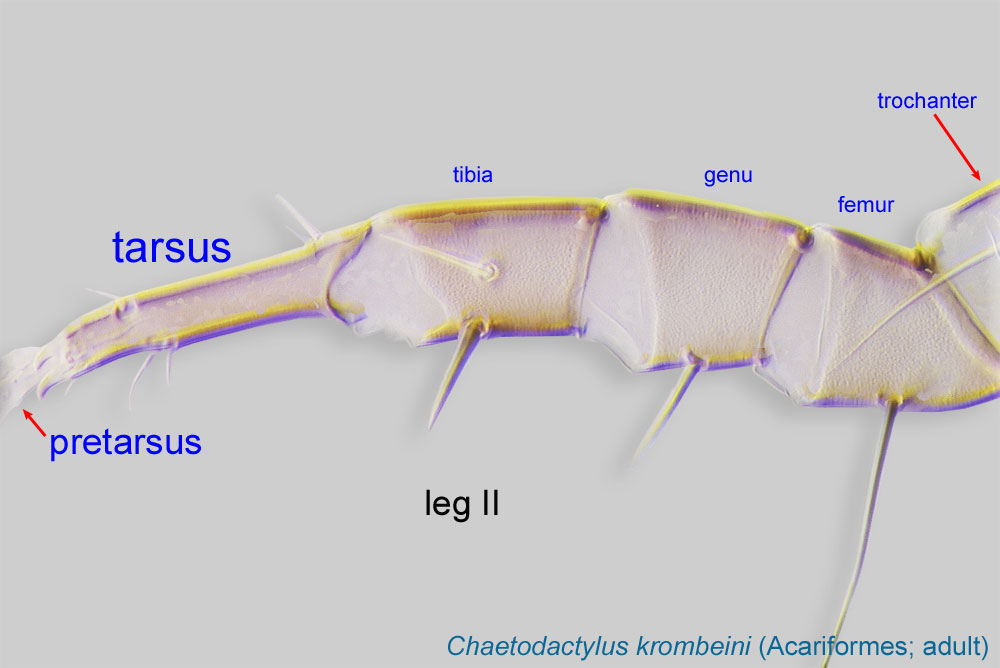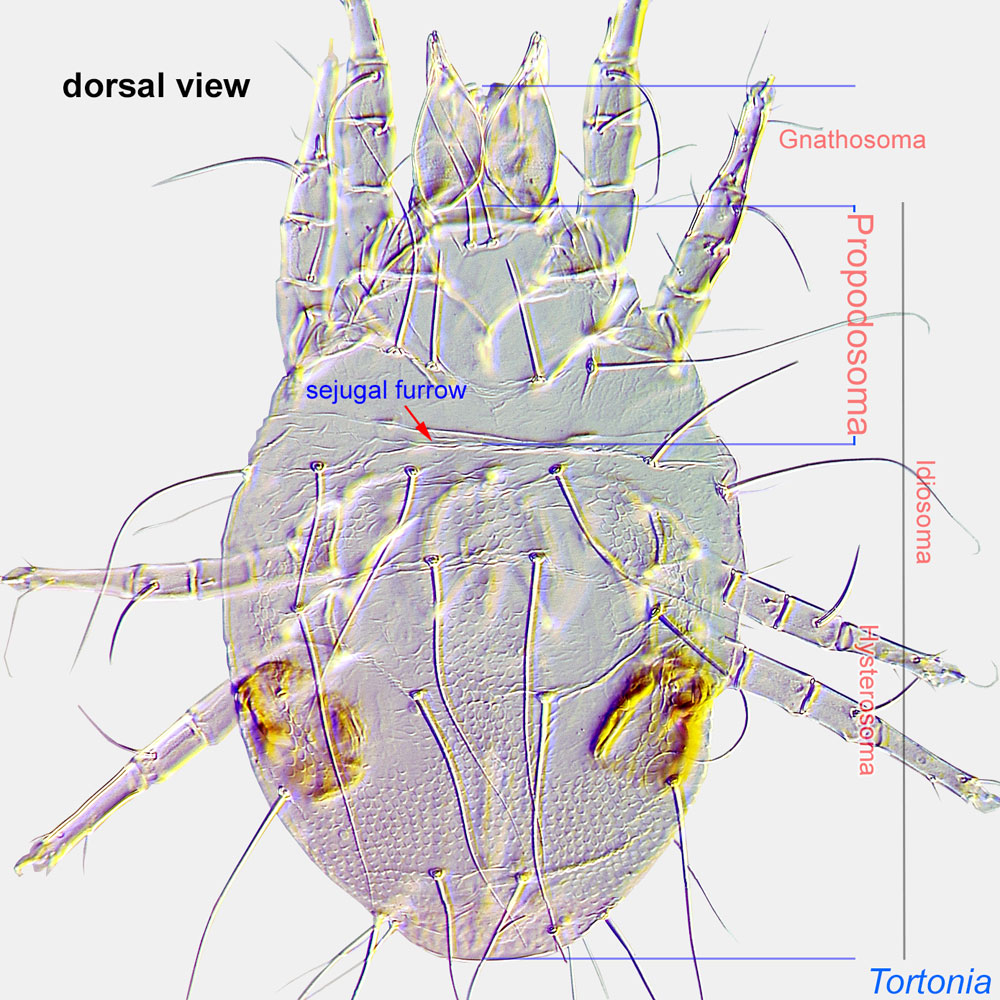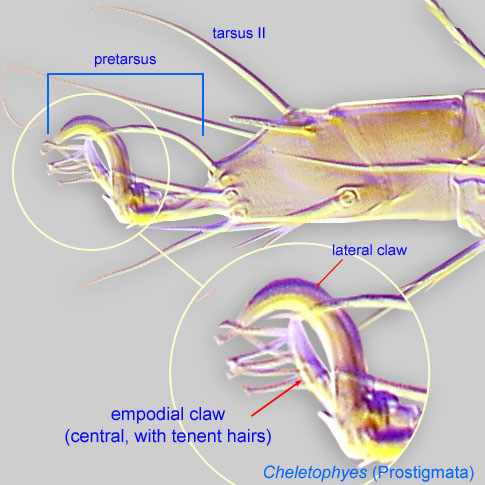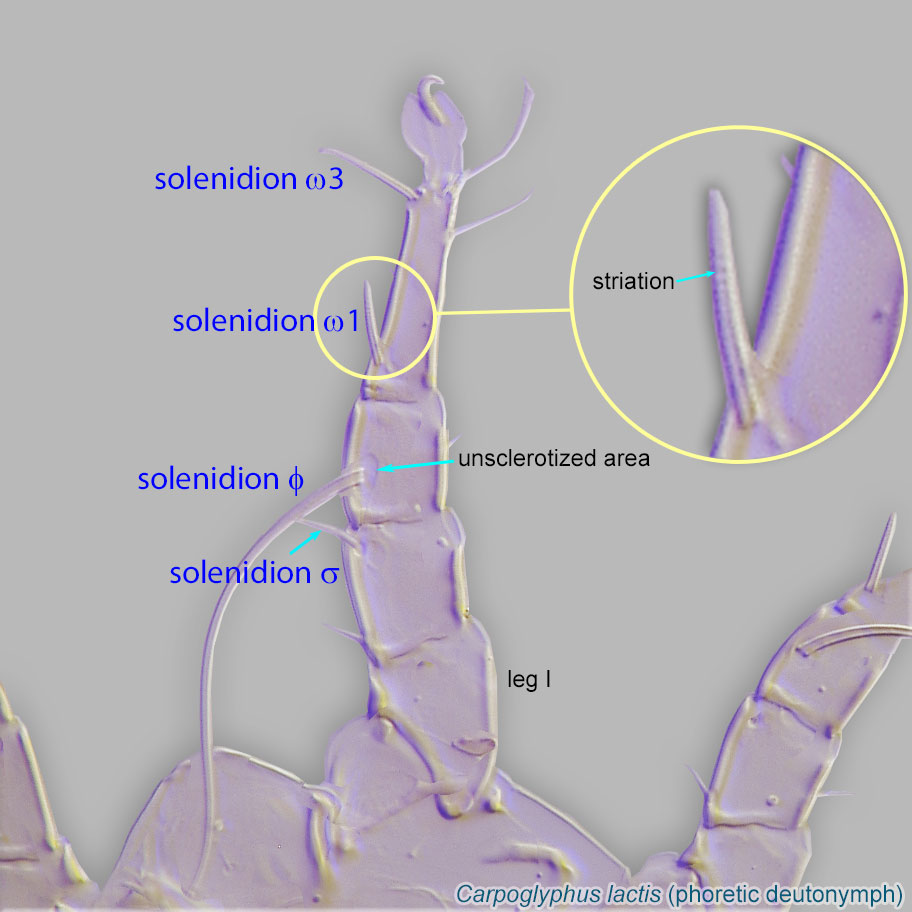probably neutral to beneficial; generalist that feeds on pollen and decomposing or fungus-infested organic matter
Suidasia Oudemans, 1905
Superorder Acariformes » Order Sarcoptiformes » Suborder Oribatida » Infraorder Desmonomata » Hyporder Astigmata » Family Suidasiidae » Genus Suidasia
Suidasia pontifica Oudemans, 1905
Aphelenia Oudemans, 1923; Chibidania Sasa, 1952. Suidasia medanensis Oudemans, 1924Oudemans, 1924:
Oudemans, A. C. 1924. Acarologische Aanteekehingen LXXVII. Entomologische Berichten (Amsterdam). 6: 317-336. (invalid name) is commonly used, but it is a junior synonym of Suidasia pontifica Oudemans, 1905 and should not be used.
scaly grain mite (Suidasia nesbitti)
Adult: Proral setae (p, q) of tarsitarsus:
Terminal segment (also known as podomere or palpomere) of legs or palps. In Parasitoformes it can be subdivided into telotarsus and basitarsus.
 I-IV, enlarged, claw-like (Fig. 8). Internal scapular setae (si) are microsetae, distinctly anterior to posterior margin of prodorsalprodorsal:
I-IV, enlarged, claw-like (Fig. 8). Internal scapular setae (si) are microsetae, distinctly anterior to posterior margin of prodorsalprodorsal:
Pertaining to the prodorsum.
shield (Fig. 3). Tarsal setae aa present (Figs. 7, 8).
Adult: Pretarsal ambulacrumambulacrum:
The claws and empodium of the apotele or pretarsus.
not greatly expanded (Figs. 7, 8). Ventral subcapitulumsubcapitulum:
Ventral faces of the fused palpcoxae.
without external ridges (Fig. 6). Body with various patterns: if with small rounded protuberances, then they are coalescent and at least some unequal (Fig 3). Dorsal setae smooth (Fig. 3). Prodorsumprodorsum:
Dorsal surface of propodosoma.
 with external vertical setae ve present, situated at sides of prodorsalprodorsal:
with external vertical setae ve present, situated at sides of prodorsalprodorsal:
Pertaining to the prodorsum.
sclerite, near transverse level of vi (Fig. 3). Anus positioned near posterior margin of body (Figs. 1, 4, 5). Coxal apodemesapodeme:
Internal sclerite that serves as an attachment site for muscles. Most commonly used (as "coxal apodeme") to describe elements of coxae fused to the ventral body in Acariformes (coxae are free and not fused to the body in Parasitiformes), and may be variously referred to as ventral, sternal, anterior, or posterior.
 III-IV present (Fig. 4). Empodial clawsEmpodial claw:
III-IV present (Fig. 4). Empodial clawsEmpodial claw:
Claw-like, membranous, or pad-like structure of setal origin. Present only on the pretarsus in Acariformes. In Astigmata, it is the only claw on the pretarsus and often referred to simply as the claw. In the remaining Acariformes, may be accomanied by two lateral claws. Also known as empodium, pretarsal empodium, or central claw.
 simple (Fig. 8). Solenidionsolenidion:
simple (Fig. 8). Solenidionsolenidion:
Thin-walled, terminally rounded or pointed filiform or peglike structure that is not birefringent in polarized light (unlike common setae in Acariformes). Often appears striated because of its internal structure. Found on the palpal tarsus on the gnathosoma and may also occur on the tarsus and tibia, less frequently on the genu, and occasionally on the femur of legs I-IV. In Acariformes, leg solenidia often arise from unsclerotized areas.
 ω2 situated in basal portion of tarsustarsus:
ω2 situated in basal portion of tarsustarsus:
Terminal segment (also known as podomere or palpomere) of legs or palps. In Parasitoformes it can be subdivided into telotarsus and basitarsus.
 , close to ω1 (Figs. 7, 8), or more distal. Setae e and f present on tarsitarsus:
, close to ω1 (Figs. 7, 8), or more distal. Setae e and f present on tarsitarsus:
Terminal segment (also known as podomere or palpomere) of legs or palps. In Parasitoformes it can be subdivided into telotarsus and basitarsus.
 I-IV, both filiform (Figs. 7, 8). Supracoxal setae lanceolate, with fimbriate margins (Fig. 3). Hysterosomal setae short, distinctly not reaching bases of next setae (Fig. 2).
I-IV, both filiform (Figs. 7, 8). Supracoxal setae lanceolate, with fimbriate margins (Fig. 3). Hysterosomal setae short, distinctly not reaching bases of next setae (Fig. 2).
A dichotomous key is available in Fain and Philips, 1978Fain and Philips, 1978:
Fain, A. amp; J. R. Philips. 1978. Notes on the genus Suidasia Oudemans, 1905 with descriptions of a new species from Australia (Acari, Astigmata, Saproglyphidae). International Journal of Acarology. 4: 115-125..
Probably cosmopolitan. Has been found in bee nests in Sri Lanka (Apis spp.) and Indonesia (Xylocopa) (Koeniger et al., 1983Koeniger et al., 1983:
Koeniger, N., G. Koeniger amp; M. Delfinado-Baker. 1983. Observations on mites of the Asian honeybee species ( Apis cerana , Apis dorsata , Apis florea ). Apidologie. 14: 197-204.; Oudemans, 1924Oudemans, 1924:
Oudemans, A. C. 1924. Acarologische Aanteekehingen LXXVII. Entomologische Berichten (Amsterdam). 6: 317-336.).
Suidasia pontifica has been found in nests of honey bees (Apis) and large carpenter bees (Xylocopa).
facultativefacultative:
can complete entire life cycle without bees or their close relative, wasps
Suidasia pontifica inhabits a variety of stored products and peridomesticperidomestic:
Of or pertaining to living in or around human habitations.
habitats, including house dust, mostly in the tropics. It causes allergic reactions, dermatitis, and rhinitis to humans (Kilpio and Pirila, 1952Kilpio and Pirila, 1952:
Kilpio, O. amp; V. Pirila. 1952. A new tyroglyphid mite causing dermatitis. Acta Derm Venereol Suppl (Stockh). 32: 197-200.). It is one of several mite species that is probably responsible for the 'pancake syndrome' (Barrera et al., 2015Barrera et al., 2015:
Barrera, O. M., I. L. Murgas, S. Bermudez amp; R. J. Miranda. 2015. [Oral anaphylaxis by ingestion of mite contaminated food in Panama City, 2011-2014]. Revista alergia Mexico. 62: 112-7.). This syndrome is known to occur in atopic individuals when eating starchy foods contaminated by mites, which induces moderate or severe, even fatal, allergic reactions.
Suidasia pontifica, as a generalist species, can invade beehives and nests of solitary bees (Xylocopa), and it feeds on dead insects, making it a pest in museum collections. This species has been recorded as part of surveys of bee nest fauna. Biology of this species inside bee nests in unknown. One work reported this species inside honeycombs of Apis cerana and Apis florea in Sri Lanka and suggested that it is a commensal (Koeniger et al., 1983Koeniger et al., 1983:
Koeniger, N., G. Koeniger amp; M. Delfinado-Baker. 1983. Observations on mites of the Asian honeybee species ( Apis cerana , Apis dorsata , Apis florea ). Apidologie. 14: 197-204.).